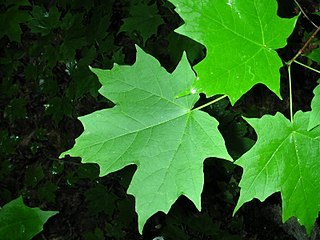
Acer saccharum, the sugar maple, is a species of flowering plant in the soapberry and lychee family Sapindaceae. It is native to the hardwood forests of eastern Canada and eastern United States. Sugar maple is best known for being the primary source of maple syrup and for its brightly colored fall foliage. It may also be called "rock maple," "sugar tree," "sweet maple," or, particularly in reference to the wood, "hard maple," "birds-eye maple," or "curly maple," the last two being specially figured lumber.
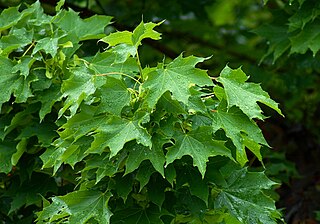
Acer platanoides, commonly known as the Norway maple, is a species of maple native to eastern and central Europe and western Asia, from Spain east to Russia, north to southern Scandinavia and southeast to northern Iran. It was introduced to North America in the mid-1700s as a shade tree. It is a member of the family Sapindaceae.

Acer campestre, known as the field maple, is a flowering plant species in the family Sapindaceae. It is native to much of continental Europe, Britain, southwest Asia from Turkey to the Caucasus, and north Africa in the Atlas Mountains. It has been widely planted, and is introduced outside its native range in Europe and areas of USA and Western Australia with suitable climate.
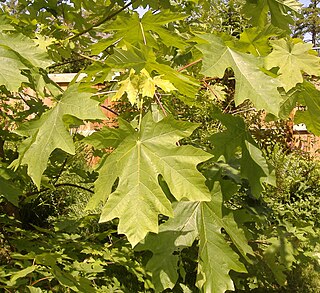
Acer macrophyllum, the bigleaf maple or Oregon maple, is a large deciduous tree in the genus Acer. It is native to western North America. In addition to uses by animals, it is of some culinary and woodworking interest.

Acer griseum, the paperbark maple or blood-bark maple, is a species of flowering plant in the family Sapindaceae, native to central China. Acer griseum is found in the Chinese provinces of Gansu, Henan, Hubei, Hunan, Shaanxi, Shanxi and Sichuan, at altitudes of 1,500–2,000 m (4,921–6,562 ft).
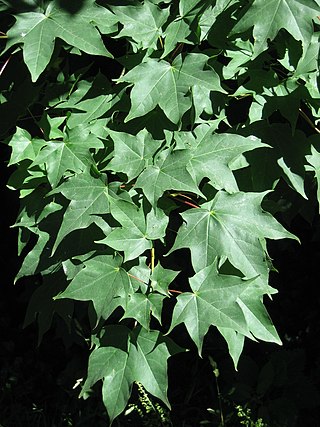
Acer cappadocicum, the Cappadocian maple, is a maple native to Asia, from central Turkey east along the Caucasus, the Himalayas, to southwestern China.

Acer ginnala, the Amur maple, is a plant species with woody stems native to northeastern Asia from easternmost Mongolia east to Korea and Japan, and north to the Russian Far East in the Amur River valley. It is a small maple with deciduous leaves that is sometimes grown as a garden subject or boulevard tree.

Acer tataricum, the Tatar maple or Tatarian maple, is a species of maple widespread across central and southeastern Europe and temperate Asia, from Austria and Turkey east as far as Japan and the Russian Far East. The species is named after the Tatar peoples of southern Russia; the tree's name is similarly commonly also misspelled "Tartar" or "Tartarian" in English.

Acer is a genus of trees and shrubs commonly known as maples. The genus is placed in the soapberry family, Sapindaceae, along with lychee and horse chestnut. There are approximately 132 species, most of which are native to Asia, with a number also appearing in Europe, northern Africa, and North America. Only one species, Acer laurinum, extends to the Southern Hemisphere. The type species of the genus is the sycamore maple, Acer pseudoplatanus, the most common maple species in Europe. Maples usually have easily recognizable palmate leaves and distinctive winged fruits. The closest relatives of the maples are the horse chestnuts. Maple syrup is made from the sap of some maple species. It is one of the most common genera of trees in Asia. Many maple species are grown in gardens where they are valued for their autumn colour.

Acer buergerianum is a species of maple native to eastern China, Taiwan and Japan. The specific epithet is a patronym honoring Dutch plant hunter J. Buerger (1804-1858).

Acer japonicum, Fullmoon Maple, Downy Japanese-Maple, is a species of maple native to Japan, on Honshū, Hokkaidō, Kyūshū, and also southern Korea.
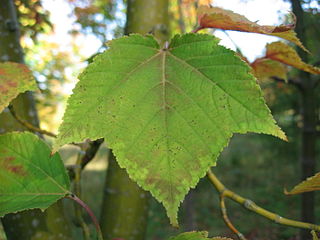
Acer rufinerve, the grey-budded snake-bark-maple, redvein maple or Honshū maple, is a species of tree in the snakebark maple group, related to Acer capillipes. It is native to mountain forests of Japan, on Honshū, Kyūshū and Shikoku.

Acer sieboldianum is a species of maple native to Japan and common in the forests of Hokkaidō, Honshū, Shikoku and Kyūshū Islands; in the south of the range it is restricted to mountain forests. It is named after Philipp Franz von Siebold.
Acer duplicatoserratum is a species of maple, native to southern and eastern mainland China and Taiwan.

Acer lobelii, known as Lobel's maple or L'Obel's maple is a rare maple tree native to southern Italy and the western Balkans. Synonyms include Acer platanoides subsp. lobelii and Acer cappadocicum Gled. subsp. lobelii (Ten.) De Jong.

Acer miyabei is a species of maple native to Japan, where it occurs in Hokkaidō and the Tōhoku region in northern Honshū.

Acer sempervirens, the Cretan maple, is a species of maple native to southern Greece and southern Turkey.

Acer pictum subsp. mono, commonly known as painted maple or mono maple in English, itayakaede (板屋楓) or ezoitaya (蝦夷板屋) in Japan, wu jiao feng (五角枫) in China, or gorosoe (고로쇠) or gorosoenamu (고로쇠나무) in Korea, is a species of maple.

Acer palmatum, commonly known as Japanese maple, palmate maple, or smooth Japanese maple (Korean: danpungnamu, 단풍나무, Japanese: irohamomiji, イロハモミジ, or momiji,, is a species of woody plant native to Korea, Japan, China, eastern Mongolia, and southeast Russia. Many different cultivars of this maple have been selected and they are grown worldwide for their large variety of attractive forms, leaf shapes, and spectacular colors.

Acer pictum, commonly known as yellow-paint maple, is an Asian species of maple. It widespread across much of China as well as Korea, Japan, Mongolia, and eastern Russia. Its natural habitat is in temperate forests.





















